Abstract
Interferometric Synthetic Aperture Radar (InSAR) is an invaluable tool for deformation monitoring. However, potential geological disaster hazards occurring in different elevation regions exhibit distinct surface deformation trends and distributions. The applicability of InSAR techniques at different elevations for monitoring potential geohazards remains uncertain. In this paper, the study area is firstly divided into typical geological disaster hazard zones based on mountainous elevation definition and SAR image elevation distribution, including areas below 1000 m, between 1000 m and 3500 m, and above 3500 m. Secondly, the spatial–temporal evolution characteristics of surface deformation from 2018 to 2020 in the study area are investigated, and potential geohazards are monitored by employing time-series InSAR techniques such as Persistent Scatterer InSAR (PS-InSAR), Small Baseline Subset InSAR (SBAS-InSAR), and Distributed Scatterer InSAR (DS-InSAR). Finally, the potential geological hazards detected by different InSAR monitoring algorithms are interpreted, and the characteristics of different InSAR monitoring algorithms in different elevation intervals are compared and analyzed. The results show that potential geological hazards are more frequent in areas between 1000 m and 3500 m in elevation, and DS-InSAR shows the best performance and accuracy in monitoring potential geological hazards in different elevation intervals.
1. Introduction
Potential geological hazards are catastrophic events, such as collapses, landslides, debris flows, and others [,]. These events are yet to occur due to natural conditions or human interference []. They typically happen in mountainous areas and involve slow surface deformation, leading to economic and property losses, casualties, environmental destruction, and other harmful effects [,,]. Monitoring ground deformation is crucial for understanding the evolution of dangerous slopes and detecting spatial and temporal changes [,]. To this end, Interferometric Synthetic Aperture Radar (InSAR) has become a widely used geological tool for various applications like terrain mapping, seismic deformation, Digital Elevation Model (DEM) reconstruction, land subsidence, mine deformation, volcanic activity, glacier drift, landslide monitoring, and deformation monitoring of large linear engineering projects [,,,]. InSAR techniques enable researchers to map displacement induced by large-scale geological hazards. Differential Interferometric Synthetic Aperture Radar (D-InSAR) is an efficient technique for measuring displacement [,,]. However, it loses coherence in the radar phase when deformation rates exceed certain thresholds []. To enhance the accuracy of displacement measurements, several multi-interferogram algorithms with spatial continuity have been developed in recent decades. Small Baseline Subset InSAR (SBAS-InSAR) identifies deformation information in distributed scatterer regions based on the coherence of their spatial distribution [,]. While SBAS-InSAR yields similar results to D-InSAR, the key difference is that the latter retrieves deformation using SAR data from orbit two to four, whereas SBAS-InSAR utilizes a larger time series of SAR images []. Permanent Scatterer InSAR (PS-InSAR) is used to identify and retrieve point targets with high coherence, making it suitable for urban areas or regions with stable interference conditions and radiation [,]. This method efficiently identifies deformation in areas with numerous permanent scatterers, human activities, wide distribution, or a large amount of data (over 20 scenes), as well as areas with slow surface deformation [,]. Recently, the focus of InSAR surface deformation time-series monitoring has shifted toward exploring Distributed Scatterers (DSs) with the introduction of SqueeSAR® technology developed by Tre Altamira in the Alpine region []. The concept of applying DS-InSAR for surface deformation monitoring was proposed when SBAS and StamPS technologies were used [,]. DS-InSAR retrieves high-precision deformation time series by performing deformation inversion in the space–time domain for both PSs and DSs in a time series of SAR images. DSs differ from PSs in terms of the physical properties, referring to point targets where the backscatter of any scatterer does not dominate within the radar resolution unit [,]. As a result, DSs increase the spatial density of coherent point targets and improve the acquisition accuracy and quantity of deformation feature information. Several studies have explored the application of InSAR for monitoring geological hazards in different environments and elevations. PS-InSAR and DS-InSAR have been widely compared in urban and mountainous areas, demonstrating their advantages in detecting deformation in coherent and distributed scatterers, respectively [,]. Recent studies have also investigated the impact of topography on InSAR performance, with findings suggesting that coherence loss and atmospheric effects vary significantly across different elevation zones. For instance, InSAR has been applied to landslide detection in the Mangkam region using SBAS-InSAR to identify potential slope instabilities across diverse terrains []. Similarly, time-series InSAR techniques have been used to identify geological hazards in Nepal’s Central Development Region, demonstrating their effectiveness in monitoring landslides and land subsidence driven by monsoon rainfall and human activities []. In addition, InSAR has been used to monitor permafrost deformation in salt lake regions [], demonstrating its capability to capture surface changes in frozen landscapes. Furthermore, recent studies have assessed the impact of tropospheric delay corrections on InSAR accuracy, particularly in complex terrain []. However, while these studies provide valuable insights into InSAR performance in specific landscapes, the comparative applicability of multiple InSAR techniques across different elevation intervals remains underexplored. To address this gap, this study evaluates PS-InSAR, SBAS-InSAR, and DS-InSAR for geological hazard monitoring at varying elevations. By systematically analyzing their effectiveness in different elevation zones, this study aims to enhance the understanding of InSAR’s adaptability in diverse topographic settings.
This study explores the suitability of InSAR technologies for monitoring geological hazards in various elevation zones. It considers the environmental and geological characteristics of different elevations and divides the study area into three zones: below 1000 m, between 1000 and 3500 m, and above 3500 m. PS-InSAR, SBAS-InSAR, and DS-InSAR methods are compared in terms of the number of deformation points and identified geological hazards in each elevation zone. Field investigations and comparisons with existing databases are conducted to verify the hazard types and risks. The characteristics of the three InSAR methods are analyzed. The results indicate that DS-InSAR is more suitable than PS-InSAR and SBAS-InSAR, as it can monitor a greater number of deformation points and geological hazards across different elevation zones.
2. Study Area and Data
2.1. Study Area
Wenchuan County, Dujiangyan, and a part of Mao County were selected as the preliminary study area. The range of the study area is between 102.939749–103.908711°E and 30.747992–32.265261°N.
Considering that a large number of active geological disaster hazards were around the Longmenshan fault zone and that the topography in this area is variant, which provided a good demonstration and different elevation intervals for research and analysis, the surrounding area of the Longmenshan fault zone in northern Sichuan Province was used. Three typical experimental zones with a total area of 5101.46 m2 were, respectively, located in the whole area of Dujiangyan, northeast of Wenchuan County, and northwest of Mao County, as shown in Figure 1.
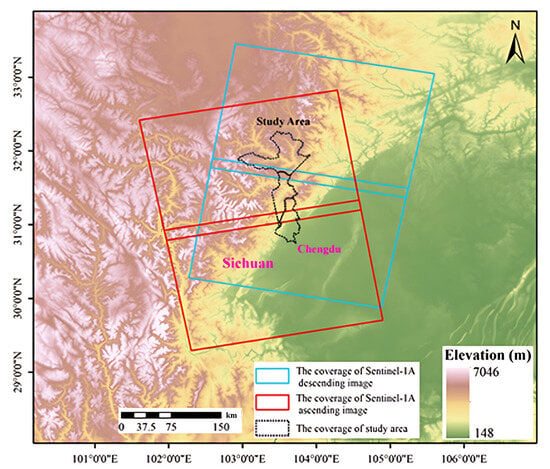
Figure 1.
Location of study area and data coverage.
The elevation distribution range of the demonstration experimental area was 148 m to 7046 m. Thus, it could be divided into three areas: low-height mountains (below 1000 m), medium-height mountains (1000~3500 m), and high-height mountains (above 3500 m). Most of the elevation areas below 1000 m belong to urban areas, while the areas with elevations of 1000 m to 3500 m and above 3500 m mostly belong to mountainous areas. Among them, the area of high-height mountains was the least in the study, mainly distributed in the northwest and southwest. The medium-height mountain area was widely distributed in the middle, north, and south. The low-height mountain area was mainly distributed near the Longmenshan fault zone and the middle and south of Dujiangyan. The study area exhibits an east–west gradient, displaying lower elevations in the central region and higher elevations on both sides. The overall elevation in the study area ranges from 600 to 5903 m. Elevated regions generally signify higher terrain slopes, incision, and undulation. Moreover, they indicate elevated susceptibility to gravitational erosion, making these areas prone to geological hazards such as landslides, collapses, and debris flows. Given the sparsity of human presence in these elevated regions, field monitoring presents considerable challenges. Consequently, these areas are conducive to the application of InSAR technology for deformation identification and monitoring.
2.2. Data and Processing Tools
Sentinel-1A Single-Look Complex (SLC) data in C-band Interferometric Wide (IW) mode were acquired from the Alaska Satellite Facility (ASF) Vertex platform. The SLC data covering the typical test area contain both amplitude and phase information, which is essential for InSAR processing. The ascending rail image includes the images of two positions, P128_F94 and P128_F99, and the descending rail image includes the images of two positions, P62_F484 and P62_F489. Based on the hazard data provided by the Sichuan Institute of Land and Space Ecological Restoration and Geological Disaster Prevention in the northern Sichuan area (Wenchuan, Maoxian, Dujiangyan), a total of 1770 typical geological hazard points were identified in the three selected study areas. Among these, there were 954 landslides, 514 collapses, 297 debris flows, and 5 ground collapses. The processing tools used in this manuscript are SARscape and GAMMA. The calculation of D-InSAR, PS-InSAR, SBAS-InSAR, and Offset Tracking algorithm models was carried out by SARscape, and GAMMA carried out the calculation of the DS-InSAR algorithm model.
Simultaneously, an analysis of different elevation intervals reveals that geological hazard points, including landslides, collapses, and debris flows, are predominantly distributed in the elevation range of 1000 to 3500 m, constituting the highest proportion at approximately 83.3%. In elevation intervals above 3500 m, the distribution of these geological hazard points is minimal, accounting for only about 0.1%. In this higher elevation range, there are no landslide, debris flow, or ground collapse hazard points, with only two points associated with collapses. On the other hand, in elevation intervals below 1000 m, geological hazard points account for approximately 16.6%, with landslides being the predominant type (218 occurrences). Additionally, a few collapses, debris flows, and ground collapses are also distributed in this elevation range, as shown in Table 1. The deformation feature information points were validated according to the geological hazards provided by the Sichuan National Spatial Ecological Restoration and Geological Disaster Prevention Research Institute. Each geological hazard point was recorded with its central elevation and latitude, along with the elevation and the area size.

Table 1.
Distribution statistics of geological hazard points in different elevation intervals (2018–2020).
3. Method
3.1. PS-InSAR
PS-InSAR is a technique used to analyze and extract coherent scatterers from specific points of interest. It relies on a substantial amount of time-series data. The process involves acquiring SAR images of the same area at different times, followed by the removal of flat and ellipsoidal phases from the images. Differential interferometric processing is then performed to generate an interferogram. Points exhibiting a high signal-to-noise ratio are identified as Permanent Scatterer (PS) targets. Finally, the PS targets are utilized for interferometric phase modeling and solutions. The flowchart of PS-InSAR is described in Figure 2a.
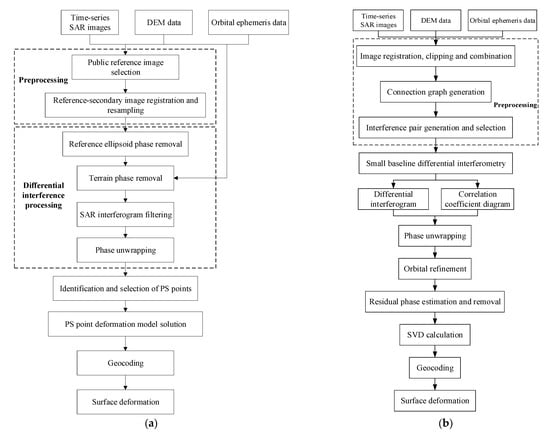
Figure 2.
Flowchart of surface deformation monitoring. (a) PS-InSAR; (b) SBAS-InSAR.
3.2. SBAS-InSAR
SBAS-InSAR is a method that minimizes the interferometric vertical baseline to reduce the impact of spatial decorrelation on data processing. This improves the overall coherence of the interferogram set and enhances deformation monitoring quality. It is suitable for studying large-scale deformations, especially in scenarios with numerous distributed scatterers. The flowchart of SBAS-InSAR is depicted in Figure 2b.
The method involves analyzing SAR image data and creating a small baseline set through interferometry. Surface deformation is then analyzed using the least squares method. Singular Value Decomposition (SVD) is employed to address matrix rank deficiency and obtain a minimum norm solution. Surface deformation time series are derived through subset calculations. Interferometric pairs with good coherence are selectively retained through quality screening based on their temporal and spatial baselines.
3.3. DS-InSAR
DS-InSAR is utilized to calculate the deformation characteristics of Persistent Scatterers (PSs) and Distributed Scatterers (DSs) in time-series SAR data. It is an interferometric measurement method that retrieves high-precision time-series deformation information []. Unlike traditional InSAR techniques that rely on highly coherent point targets like PS-InSAR, DS-InSAR incorporates distributed scatterers to effectively increase the spatial density of coherent points. The application of distributed objects in surface deformation monitoring with DS-InSAR involves two key steps: (1) adaptive phase filtering and multi-view processing, and (2) optimal phase estimation under phase consistency. DS points and PS points are then jointly decoded for further analysis.
The flowchart of surface deformation monitoring in different elevation intervals by DS-InSAR is described in Figure 3.
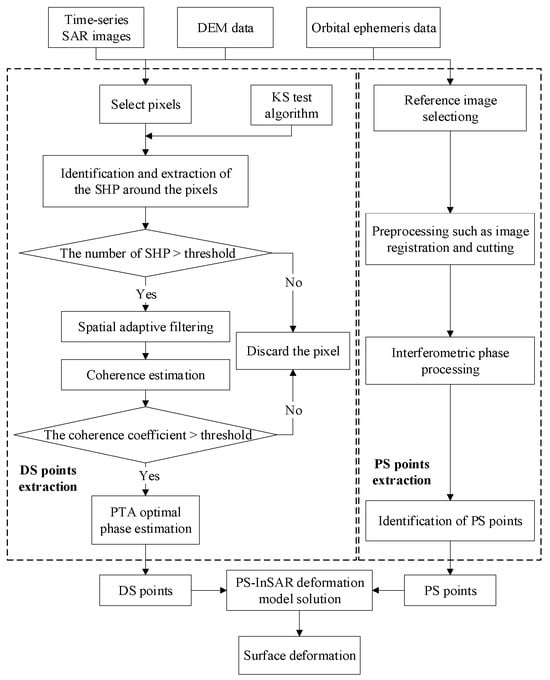
Figure 3.
Flowchart of surface deformation monitoring by DS-InSAR.
In this study, the SAR and DEM data were categorized into three elevation intervals: below 1000 m, 1000 to 3500 m, and above 3500 m in the study area. The Kolmogorov–Smirnov (K-S) test was employed to identify Statistical Homogeneity Points (SHPs) surrounding each pixel. Spatial adaptive filtering was then applied to pixels that met the given threshold of the surrounding SHP count. A coherence assessment was performed on the processed pixels, and those with a coherence coefficient exceeding the specified threshold were selected as candidates for PTA optimal phase estimation, resulting in the formation of the DS point set. Additionally, a PS point set was obtained separately and combined with the DS point set. The integrated point sets were incorporated into the PS-InSAR processing framework to derive surface deformation. The monitoring results were compared, and factors such as vegetation coverage, slope, and rainfall in different elevation regions were analyzed. An evaluation of the applicability of DS-InSAR in different elevation intervals was conducted based on the comparative analysis.
The backscattering coefficient of any pixel P in a SAR image can be expressed as follows:
where di(P) is the plural reflectance of the ith image, while d(P) is a constant vector for the PS point and a random vector for the DS point.
Based on the maximum difference absolute value of the distribution function of the two data sets, the KS test analyzes the stability of the random variable of the DS point under parameterization by identifying whether pixels P1 and P2 are statistically uniform pixels. The KS test can be expressed as follows:
where SNP1(x) and SNP2(x) are distribution functions of pixels P1 and P2, respectively. Sup is short for supremum and N stands for data set. The probability distributional function DN can be estimated by the empirical KS and can be expressed as follows [,]:
where P (DN ≤ t) represents the probability that the KS statistic DN is less than or equal to a certain threshold t, which is the cumulative distribution function (CDF) of the KS statistic. The KS test judges whether DN overcomes the set threshold t to identify whether P1 and P2 are in the same distribution.
Spatial adaptive filtering is proposed to reduce noise. It is generally utilized in speckle removal, interferogram filtering, and covariance matrix estimation []. Through the spatial adaptive filtering of DS candidate points, the phase time series can be recovered point by point to improve the coherence of DS candidate points.
The PTA (Phase Triangulation Algorithm) is often applied to consider and process the DS, so as to improve the spatial density of measurement points of PS-InSAR. The interferometric phase constructed by the PTA has less noise than that retrieved by spatial filtering, which makes the spatial phase unwrapping process more robust, enabling it to select N optimal phase values (PSs) for DS points from N (N − 1)/2 interferometric pairs [].
As a supplement and extension algorithm of D-InSAR, PS-InSAR focuses on solving the problems of traditional D-InSAR, such as time decoherence and atmospheric delay. PS-InSAR does not retrieve all pixels in the SAR images but recognizes ground targets with relatively stable scattering characteristics and strong echo signals in the period. These target points usually include artificial buildings, lighthouses, exposed rocks, and manually deployed corner reflectors []. DS-InSAR is developed based on the improvement in PS-InSAR. Therefore, these two methods are fundamentally unified, so the processing flow can be universally used.
4. Results
4.1. Surface Deformation and Spatial Distribution
The PS-InSAR, SBAS-InSAR, and DS-InSAR techniques were tested to process 46 images from Sentinel-1A data, and then the time-series surface deformation monitoring results of three elevation intervals of below 1000 m, 1000 to 3500 m, and above 3500 m of the study area were acquired. The surface deformation results presented in Figure 4 and Figure 5 represent displacement in the satellite’s line of sight (LOS) for both ascending and descending orbits. Negative LOS deformation values (blue to green) indicate uplift, while positive values (yellow to red) indicate subsidence.
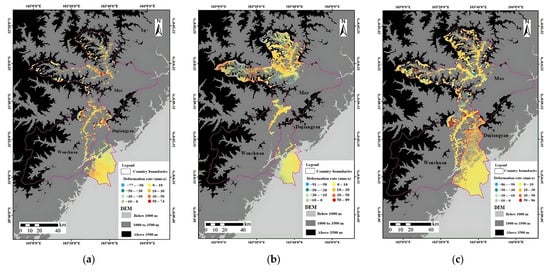
Figure 4.
Annual average surface deformation rate distribution of Sentinel-1A ascending data by InSAR technologies (LOS displacement): (a) PS-InSAR; (b) SBAS-InSAR; (c) DS-InSAR.
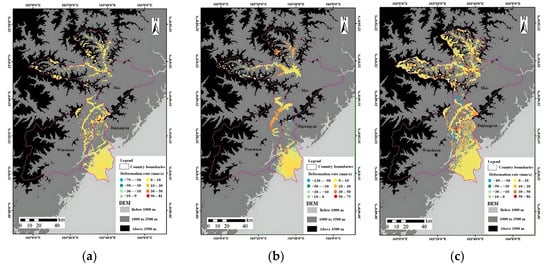
Figure 5.
Annual average surface deformation rate results of Sentinel-1A descending data by InSAR technologies (LOS displacement): (a) PS-InSAR; (b) SBAS-InSAR; (c) DS-InSAR.
The range of surface deformation rates detected by DS-InSAR in the areas of elevation below 1000 m, 1000 to 3500 m, and above 3500 m are, respectively, from −50 to 46 mm/a, from −86 to 86 mm/a, and from −85 to 84 mm/a. From Figure 5 and Figure 6, it can be seen that information points identified by DS-InSAR in the areas of elevation are more dense compared to other InSAR methods.
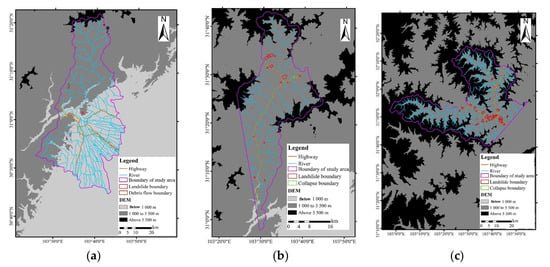
Figure 6.
Types and regional distribution of potential geological hazards monitored: (a) obtained in Dujiangyan; (b) obtained in parts of Wenchuan County; (c) obtained in parts of Mao County.
By comparing the number of points obtained by different InSAR technologies, the applicability of the DS-InSAR method for surface deformation monitoring in different elevation intervals was analyzed. The distribution of deformation feature information points obtained by different InSAR technologies in different elevation intervals is shown in Table 2.

Table 2.
Different InSAR techniques in different elevation intervals comprehensive interpretation.
Table 2 demonstrates that the DS-InSAR method detects the highest number of deformation feature information points in the elevation areas below 1000 m and above 3500 m in the study area. Additionally, DS-InSAR identifies the largest total number of deformation feature information points across different elevation ranges.
In the elevation interval below 1000 m, comprehensive remote sensing monitoring detects only a small number of potential geological hazard points. By comparing the number of deformation feature points extracted by different temporal InSAR algorithms (PS-InSAR, SBAS-InSAR, DS-InSAR) in this interval, it is evident that DS-InSAR outperforms the other two algorithms, with 182,960 deformation points detected. This highlights the superior applicability of DS-InSAR in the elevation interval below 1000 m within the experimental area.
For the elevation range of 1000–3500 m, both SBAS-InSAR and DS-InSAR algorithms are suitable for comprehensive remote sensing monitoring of geological hazard potential. Comparative analysis reveals that SBAS-InSAR and DS-InSAR extract a relatively higher number of deformation points in the experimental area compared to PS-InSAR. Specifically, SBAS-InSAR detects 137,316 deformation points, while DS-InSAR identifies 80,430 deformation points. This reinforces the suitability of SBAS-InSAR and DS-InSAR in the elevation range of 1000–3500 m within the typical experimental area.
Although no geological hazards are present above 3500 m in the study area, the applicability of different algorithms in this elevation range varies. By comparing and analyzing the results in Table 2, it is observed that SBAS-InSAR and DS-InSAR outperform PS-InSAR, with 90,452 and 111,315 deformation points detected, respectively. This suggests that SBAS-InSAR and DS-InSAR may have relatively better applicability in the elevation interval above 3500 m.
Overall, the DS-InSAR method detects the highest number of geological disaster hazards, particularly in medium-height mountains (1000–3500 m), and also demonstrates advantages in low-height mountains (below 1000 m) compared to the other two methods. Moreover, DS-InSAR identifies the largest total number of geological disaster hazards.
4.2. Distribution of Potential Geological Hazard Monitoring
After comparing and analyzing the results of PS-InSAR, SBAS-InSAR, and DS-InSAR time-series surface deformation inversion, a total of 47 potential geological hazards were monitored in the study area. Among them, 2 were located in Dujiangyan, 15 in parts of Wenchuan County, and 30 in parts of Mao County (as shown in Figure 6). The primary types of hazards in Dujiangyan were landslides and debris flows, while landslides and collapses were predominant in Wenchuan County and Mao County. These potential geological hazards were mainly distributed in areas near roads and rivers.
Considering the elevation intervals in the study area (as shown in Table 3), the largest number of potential geological hazards was found in the range between 1000 and 3500 m. The main type of hazard in this interval was landslides, with a few cases of collapses and debris flows. Below 1000 m, the number of potential geological hazards was relatively smaller, primarily consisting of collapses and debris flows. In the regions above 3500 m, no potential geological hazards were monitored due to the unique geographical environment and the combined influence of factors such as snow cover, ablation, and rainfall. Even if the time-series InSAR technologies identified areas with significant surface deformation, subsequent interpretation and analysis of high-resolution optical images concluded that they did not pose potential geological hazards. As a result, no potential geological hazards were identified in the regions above 3500 m in the study area.

Table 3.
Comprehensive interpretation of different InSAR techniques in different elevation intervals.
5. Discussion
The results obtained from the application of PS-InSAR, SBAS-InSAR, and DS-InSAR methods to Sentinel-1 data provide valuable insights into the spatial and temporal characteristics of surface deformation in the study area. The observed deformation patterns reveal that both landslides and subsidence are prevalent, with clear correlations to environmental and anthropogenic factors.
PS-InSAR focuses on analyzing point targets and retrieving scatterers with high coherence. It requires a substantial amount of SAR time-series data to obtain reliable PS points and deformation information. This method is particularly suitable for urban areas or regions with relatively stable interference conditions and high numbers of permanent scatterers [,]. As demonstrated in this study, PS-InSAR successfully captured deformation in regions with frequent human engineering activities and slow surface displacement trends. However, due to its reliance on high coherence, its performance was limited in densely vegetated and topographically complex regions.
On the other hand, SBAS-InSAR is better suited for analyzing distributed targets by leveraging short baseline interferometric pairs, which increases the time sampling rate and provides high-spatial-density measurements of deformation [,]. The results indicate that SBAS-InSAR effectively captured deformation in mountainous regions, where distributed scatterers dominate []. However, an observed limitation is the significantly lower number of deformation feature points in the SBAS-InSAR descending orbit for the elevation above 3500 m (only 2715 points) compared to other configurations. This discrepancy can be attributed to temporal and spatial coherence differences and differences in acquisition geometry. SBAS-InSAR relies on multi-temporal interferograms, and in high-relief regions, decorrelation due to vegetation, atmospheric conditions, and land cover changes can lead to a reduced number of identified deformation points. The ascending and descending orbits capture surface deformation from different angles, affecting sensitivity to certain types of displacement. Deformation predominantly occurring in the east–west direction may be less detectable in descending-mode observations.
DS-InSAR demonstrated significant advantages in monitoring geological hazards across different elevation intervals. Compared to PS-InSAR and SBAS-InSAR, DS-InSAR identified a higher density of deformation points, especially in mountainous regions between 1000 m and 3500 m, where landslides and collapses were most prevalent. The ability of DS-InSAR to integrate both persistent and distributed scatterers contributed to its superior performance in capturing deformation trends in complex terrains.
Furthermore, the analysis of geological hazards in different elevation intervals revealed that landslides and collapses were predominantly concentrated in areas between 1000 and 3500 m, aligning with previous studies indicating that such elevations are particularly prone to mass movements due to steep slopes, rainfall influence, and geological conditions. In contrast, subsidence was more commonly observed in lower elevation areas (<1000 m), where anthropogenic activities such as groundwater extraction and infrastructure development played a significant role.
The methodological implications of this study highlight that SBAS-InSAR is particularly effective in detecting gradual, widespread deformation, whereas PS-InSAR provides higher precision for localized deformation. DS-InSAR, by incorporating both techniques, offers a more comprehensive approach for monitoring geological hazards across different elevation zones. Future research should focus on refining InSAR-derived deformation interpretations by integrating auxiliary data sets such as field surveys, geotechnical data, and hydrological models. Additionally, addressing atmospheric and tropospheric delay corrections will further enhance the accuracy and reliability of deformation monitoring in complex terrains. By incorporating multi-source SAR data and optimizing data processing techniques, future studies can improve the precision of geological hazard assessments and contribute to more effective disaster prevention and mitigation strategies.
6. Conclusions and Outlook
This study applied the DS-InSAR method to monitor surface deformation across different elevation intervals in Dujiangyan, Mao County, and Wenchuan County. The results demonstrate that DS-InSAR effectively captures long-term deformation trends of geological hazards and provides a higher spatial density of coherent targets compared to traditional time-series InSAR methods such as PS-InSAR and SBAS-InSAR. By integrating both persistent and distributed scatterers, DS-InSAR enhances the accuracy of remote sensing-based geological hazard interpretation, making it a valuable tool for large-scale deformation monitoring.
A key finding of this study is the elevation-dependent variation in geological hazards. The analysis revealed that deformation events, including landslides and subsidence, are predominantly concentrated in the 1000–3500 m elevation range, aligning with previous research indicating that this interval is most susceptible to mass movements. In contrast, subsidence events were more frequently observed in lower elevation areas (<1000 m), where anthropogenic activities such as groundwater extraction play a significant role.
However, several limitations were encountered. The use of Sentinel-1A data as the sole SAR source led to overlapping mask issues due to the large terrain variations in the study area, resulting in the loss of some effective deformation information. Additionally, differences in coherence and layover effects impacted the effectiveness of different InSAR techniques in specific elevation intervals, with SBAS-InSAR in the descending orbit detecting significantly fewer deformation points. To address these challenges, future research should focus on integrating multi-source and multi-angle SAR data to improve data completeness and accuracy, refining atmospheric and tropospheric corrections to mitigate phase noise and enhance reliability in complex terrains, and incorporating geotechnical and hydrological data to better understand the driving mechanisms behind observed deformation trends. By advancing these methodologies, future studies can further enhance the capabilities of InSAR-based geological hazard monitoring and contribute to more effective disaster prevention and mitigation strategies.
Author Contributions
Methodology, Z.Z., Y.L., T.S. and W.H.; formal analysis, C.X. and T.S.; resources, M.Z., B.S. and H.T.; data curation, T.S.; supervision, Y.H. and M.Z.; Writing—original draft, J.H. and Y.L.; Writing—review & editing, Z.Z. and Y.L. All authors have read and agreed to the published version of the manuscript.
Funding
This work is supported in part by Sichuan Research Institute for Ecosystem Restoration & Geohazard Prevention (Grant No. YG-2020-05); and The Key Science and Technology Project of Yunnan Province (Grant No. 202202AD08004).
Data Availability Statement
The data presented in this study are available on request from the corresponding author due to privacy.
Conflicts of Interest
The authors report no conflicts of interest.
References
- Tan, Q.; Huang, Y.; Hu, J.; Zhou, P.; Hu, J. Application of artificial neural network model based on GIS in geological hazard zoning. Neural Comput. Appl. 2021, 33, 591–602. [Google Scholar] [CrossRef]
- Zhang, X.; Wu, Y.; Zhai, E.; Ye, P. Coupling analysis of the heat-water dynamics and frozen depth in a seasonally frozen zone. J. Hydrol. 2021, 593, 125603. [Google Scholar] [CrossRef]
- Wang, X.; Zhang, Q.; Zhao, C.; Qu, F.; Zhang, J. A novel method of generating deformation time-series using interferometric synthetic aperture radar and its application in Mexico City. Remote Sens. 2018, 10, 1741. [Google Scholar] [CrossRef]
- Haque, U.; Blum, P.; da Silva, P.F.; Andersen, P.; Pilz, J.; Chalov, S.R.; Malet, J.-P.; Auflič, M.J.; Andres, N.; Poyiadji, E.; et al. Fatal landslides in Europe. Landslides 2016, 13, 1545–1554. [Google Scholar] [CrossRef]
- Intrieri, E.; Carlà, T.; Gigli, G. Forecasting the time of failure of landslides at slope-scale: A literature review. Earth-Sci. Rev. 2019, 193, 333–349. [Google Scholar] [CrossRef]
- Froude, M.J.; Petley, D.N. Global fatal landslide occurrence from 2004 to 2016. Nat. Hazards Earth Syst. Sci. 2018, 18, 2161–2181. [Google Scholar] [CrossRef]
- Scheikl, M.; Angerer, H.; Dolzlmuller, J.; Poisel, R.; Poscher, G. Multidisciplinary monitoring demonstrated in the case study of the Eiblschrofen rockfall. Felsbau 2000, 18, 24–29. [Google Scholar]
- Loew, S.; Gschwind, S.; Gischig, V.; Keller-Signer, A.; Valenti, G. Monitoring and early warning of the 2012 Preonzo catastrophic rockslope failure. Landslides 2017, 14, 141–154. [Google Scholar] [CrossRef]
- Zebker, H.A.; Goldstein, R.M. Topographic mapping from interferometric synthetic aperture radar observations. J. Geophys. Res. Solid Earth 1986, 91, 4993–4999. [Google Scholar] [CrossRef]
- Neelmeijer, J.; Motagh, M.; Wetzel, H.-U. Estimating spatial and temporal variability in surface kinematics of the Inylchek Glacier, central Asia, using TerraSAR–X Data. Remote Sens. 2014, 6, 9239–9259. [Google Scholar] [CrossRef]
- Albano, M.; Barba, S.; Saroli, M.; Moro, M.; Malvarosa, F.; Costantini, M.; Bignami, C.; Stramondo, S. Gravity-driven postseismic deformation following the Mw 6.3 2009 L’Aquila (Italy) earthquake. Sci. Rep. 2015, 5, 16558. [Google Scholar] [CrossRef]
- Walter, T.; Subandriyo, J.; Kirbani, S.; Bathke, H.; Suryanto, W.; Aisyah, N.; Darmawan, H.; Jousset, P.; Luehr, B.-G.; Dahm, T. Volcano-tectonic control of Merapi’s lava dome splitting: The November 2013 fracture observed from high resolution TerraSAR-X data. Tectonophysics 2015, 639, 23–33. [Google Scholar] [CrossRef]
- Bamler, R.; Hartl, P. Synthetic aperture radar interferometry. Inverse Probl. 1998, 14, R1. [Google Scholar] [CrossRef]
- Rosen, P.A.; Hensley, S.; Joughin, I.R.; Li, F.K.; Madsen, S.N.; Rodriguez, E.; Goldstein, R.M. Synthetic aperture radar interferometry. Proc. IEEE 2000, 88, 333–382. [Google Scholar] [CrossRef]
- Rott, H. Advances in interferometric synthetic aperture radar (InSAR) in earth system science. Prog. Phys. Geogr. Earth Environ. 2009, 33, 769–791. [Google Scholar] [CrossRef]
- Casu, F.; Manconi, A.; Pepe, A.; Lanari, R. Deformation time-series generation in areas characterized by large displacement dynamics: The SAR amplitude Pixel-Offset SBAS technique. IEEE Trans. Geosci. Remote Sens. 2011, 49, 2752–2763. [Google Scholar] [CrossRef]
- Wu, Q.; Jia, C.; Chen, S.; Li, H. SBAS-InSAR based deformation detection of urban land, created from mega-scale mountain excavating and valley filling in the Loess Plateau: The Case Study of Yan’an City. Remote Sens. 2019, 11, 1673. [Google Scholar] [CrossRef]
- Wang, B.; Zhao, C.; Zhang, Q.; Lu, Z.; Li, Z.; Liu, Y. Sequential estimation of dynamic deformation parameters for SBAS-InSAR. IEEE Geosci. Remote Sens. Lett. 2020, 17, 1017–1021. [Google Scholar] [CrossRef]
- Chen, Y.; Yu, S.; Tao, Q.; Liu, G.; Wang, L.; Wang, F. Accuracy verification and correction of D-InSAR and SBAS-InSAR in monitoring mining surface subsidence. Remote Sens. 2021, 13, 4365. [Google Scholar] [CrossRef]
- Hussain, M.A.; Chen, Z.; Wang, R.; Shoaib, M. PS-InSAR-based validated landslide susceptibility mapping along Karakorum Highway, Pakistan. Remote Sens. 2021, 13, 4129. [Google Scholar] [CrossRef]
- Lyu, M.; Ke, Y.; Li, X.; Zhu, L.; Guo, L.; Gong, H. Detection of seasonal deformation of highway overpasses using the PS-InSAR Technique: A case study in Beijing Urban Area. Remote Sens. 2020, 12, 3071. [Google Scholar] [CrossRef]
- Wang, H.; Feng, G.; Xu, B.; Yu, Y.; Li, Z.; Du, Y.; Zhu, J. Deriving spatio-temporal development of ground subsidence due to subway construction and operation in delta regions with PS-InSAR data: A case study in Guangzhou, China. Remote Sens. 2017, 9, 1004. [Google Scholar] [CrossRef]
- Narayan, A.B.; Tiwari, A.; Dwivedi, R.; Dikshit, O. A novel measure for categorization and optimal phase history retrieval of distributed scatterers for InSAR applications. IEEE Trans. Geosci. Remote Sens. 2018, 56, 5843–5849. [Google Scholar] [CrossRef]
- Ferretti, A.; Fumagalli, A.; Novali, F.; Prati, C.; Rocca, F.; Rucci, A. A new algorithm for processing interferometric data-stacks: SqueeSAR. IEEE Trans. Geosci. Remote Sens. 2011, 49, 3460–3470. [Google Scholar] [CrossRef]
- Berardino, P.; Fornaro, G.; Lanari, R.; Sansosti, E. A new algorithm for surface deformation monitoring based on small baseline differential SAR interferograms. IEEE Trans. Geosci. Remote Sens. 2002, 40, 2375–2383. [Google Scholar] [CrossRef]
- Hooper, A. A multi-temporal InSAR method incorporating both persistent scatterer and small baseline approaches. Geophys. Res. Lett. 2008, 35, L16302. [Google Scholar] [CrossRef]
- Anfinsen, S.N.; Eltoft, T. Application of the Matrix-Variate Mellin transform to analysis of polarimetric radar images. IEEE Trans. Geosci. Remote Sens. 2011, 49, 2281–2295. [Google Scholar] [CrossRef]
- Eneva, M.; Adams, D.; Falorni, G.; Morgan, J. Surface deformation in Imperial Valley, CA, from satellite radar interferometry. Trans. Geotherm. Resour. Counc. 2012, 36, 1339–1344. [Google Scholar]
- Zhang, Y.; Li, Y.; Dong, J.; Fan, Q.; Che, B.; Zhang, L.; Zhou, Y.; Liao, M. Landslide hazard detection in Markam with time-series InSAR analyses. Natl. Remote Sens. Bull. 2021, 23, 987–996. [Google Scholar]
- Wang, Y.; Wang, S.; Wang, N. Application of Time Series InSAR Technology in Early Identification of Geological Hazards in the Northern Part of Central Development Zone of Nepal. South China Geol. 2023, 39, 536–547. [Google Scholar]
- Huang, S.B.; Chang, Z.Q.; Xie, C.; Tian, B.S. Deformation monitoring of frozen soil in salt lake area based on SBAS-InSAR. Adv. Geosci. 2020, 10, 100–120. [Google Scholar]
- Ma, Y.; Liu, T.; Yu, Z.; Jiang, C.; Lu, Z. Assessment of numerical weather models with different spatial resolutions on tropospheric delay correction for InSAR. IEEE J. Sel. Top. Appl. Earth Obs. Remote Sens. 2024, 17, 14133–14144. [Google Scholar] [CrossRef]
- Tang, P.; Chen, F.; Guo, H.; Tian, B.; Wang, X.; Ishwaran, N. Large-area landslides monitoring using advanced multi-temporal InSAR technique over the Giant Panda habitat, Sichuan, China. Remote Sens. 2015, 7, 8925–8949. [Google Scholar] [CrossRef]
- Stephens, M.A. Use of the Kolmogorov-Smirnov, Cramer-Von Mises and related statistics without extensive tables. J. R. Stat. Soc. Ser. B (Methodol.) 1970, 32, 115–122. [Google Scholar]
- Press, W.H.; Teukolsky, S.A.; Vetterling, W.T.; Flannery, B.P. Numerical Recipes 3rd Edition: The Art of Scientific Computing; Cambridge University Press: Cambridge, UK; New York, NY, USA, 2007. [Google Scholar]
- Lv, X.; Yazıcı, B.; Zeghal, M.; Bennett, V.; Abdoun, T. Joint-scatterer processing for time-series InSAR. IEEE Trans. Geosci. Remote Sens. 2014, 52, 7205–7221. [Google Scholar] [CrossRef]
- Cao, N.; Lee, H.; Jung, H.C. Mathematical framework for Phase-Triangulation Algorithms in distributed-scatterer interferometry. IEEE Geosci. Remote Sens. Lett. 2015, 12, 1838–1842. [Google Scholar] [CrossRef]
- Ferretti, A.; Prati, C.; Rocca, F. Permanent scatterers in SAR interferometry. IEEE Trans. Geosci. Remote Sens. 2001, 39, 8–20. [Google Scholar] [CrossRef]
- Yan, Y.; Doin, M.-P.; Lopez-Quiroz, P.; Tupin, F.; Fruneau, B.; Pinel, V.; Trouve, E. Mexico City subsidence measured by InSAR time series: Joint analysis using PS and SBAS approaches. IEEE J. Sel. Top. Appl. Earth Obs. Remote Sens. 2012, 5, 1312–1326. [Google Scholar] [CrossRef]
- Azar, M.K.; Hamedpour, A.; Maghsoudi, Y.; Perissin, D. Analysis of the deformation behavior and sinkhole risk in Kerdabad, Iran using the PS-InSAR method. Remote Sens. 2021, 13, 2696. [Google Scholar] [CrossRef]
- Zhou, L.; Guo, J.; Hu, J.; Li, J.; Xu, Y.; Pan, Y.; Shi, M. Wuhan surface subsidence analysis in 2015–2016 based on Sentinel-1A data by SBAS-InSAR. Remote Sens. 2017, 9, 982. [Google Scholar] [CrossRef]
- Zhang, L.; Dai, K.; Deng, J.; Ge, D.; Liang, R.; Li, W.; Xu, Q. Identifying potential landslides by Stacking-InSAR in southwestern China and Its Performance Comparison with SBAS-InSAR. Remote Sens. 2021, 13, 3662. [Google Scholar] [CrossRef]
- Aimaiti, Y.; Yamazaki, F.; Liu, W.; Kasimu, A. Monitoring of land-surface deformation in the Karamay oilfield, Xinjiang, China, Using SAR Interferometry. Appl. Sci. 2017, 7, 772. [Google Scholar] [CrossRef]
Disclaimer/Publisher’s Note: The statements, opinions and data contained in all publications are solely those of the individual author(s) and contributor(s) and not of MDPI and/or the editor(s). MDPI and/or the editor(s) disclaim responsibility for any injury to people or property resulting from any ideas, methods, instructions or products referred to in the content. |
© 2025 by the authors. Licensee MDPI, Basel, Switzerland. This article is an open access article distributed under the terms and conditions of the Creative Commons Attribution (CC BY) license (https://creativecommons.org/licenses/by/4.0/).